Ingrid Bergman (29 August 1915 – 29 August 1982) was a Swedish actress who starred in a variety of European and American films. She won three Academy Awards, two Emmy Awards, and the Tony Award for Best Actress. She is ranked as the fourth greatest female star of American cinema of all time by the American Film Institute. She is best remembered for her roles as Ilsa Lund in Casablanca (1942), a World War II drama co-starring Humphrey Bogart and as Alicia Huberman in Notorious (1946), an Alfred Hitchcock thriller co-starring Cary Grant.
Before becoming a star in American films, she had already been a leading actress in Swedish films. Her first introduction to American audiences came with her starring role in the English remake of Intermezzo in 1939. In America, she brought to the screen a "Nordic freshness and vitality", along with exceptional beauty and intelligence, and according to the St. James Encyclopedia of Popular Culture, she quickly became "the ideal of American womanhood" and one of Hollywood's greatest leading actresses.
Her producer David O. Selznick, who called her "the most completely conscientious actress" he had ever worked with, gave her a seven-year acting contract, thereby supporting her continued success. A few of her other starring roles, besides Casablanca, included For Whom the Bell Tolls (1943), Gaslight (1944), The Bells of St. Mary's (1945), Alfred Hitchcock's Spellbound (1945), Notorious (1946), and Under Capricorn (1949), and the independent production, Joan of Arc (1948).
In 1950, after a decade of stardom in American films, she starred in the Italian film Stromboli, which led to a love affair with director Roberto Rossellini while they were both already married. The affair created a scandal that forced her to return to Europe until 1956, when she made a successful Hollywood comeback in Anastasia, for which she won her second Academy Award, as well as the forgiveness of her fans. Many of her personal and film documents can be seen in the Wesleyan University Cinema Archives.
Early years: 1915–1938
Bergman, named after Princess Ingrid of Sweden, was born in Stockholm, Sweden on 29 August 1915 to a Swedish father, Justus Samuel Bergman, and a German mother, Friedel (Adler) Bergman. When she was three years of age, her mother died. Her father, who was an artist and photographer, died when she was thirteen. In the years before he died, he wanted her to become an opera star, and had her take voice lessons for three years. But she always "knew from the beginning that she wanted to be an actress", sometimes wearing her mother's clothes and staging plays in her father's empty studio. Her father documented all her birthdays with a borrowed camera.After his death, she was then sent to live with an aunt, who died of heart complications only six months later. She then moved in with her Aunt Hulda and Uncle Otto, who had five children. Another aunt she visited, Elsa Adler, first told Ingrid, when she was 11, that her mother may have "some Jewish blood", and that her father was aware of that fact long before they married. But her aunt also cautioned her about telling others about her possible ancestry as "there might be some difficult times coming."
At the age of 17, Bergman was allowed only one chance to become an actress by entering an acting competition with the Royal Dramatic Theatre in Stockholm. Bergman recalls her feelings during that competition:
- "As I walked off the stage, I was in mourning, I was at a funeral. My own. It was the death of my creative self. My heart had truly broken... they didn't think I was even worth listening to, or watching."
- "We loved your security and your impertinence. We loved you and told each other that there was no reason to waste time as there were dozens of other entrants still to come. We didn't need to waste any time with you. We knew you were a natural and great. Your future as an actress was settled."
Hollywood period: 1939–1949
Intermezzo: A Love Story (1939)
Bergman's first acting role in America came when Hollywood producer David O. Selznick brought her to America to star in Intermezzo: A Love Story, an English language remake of her 1936 Swedish film, Intermezzo. Unable to speak English and uncertain about her acceptance by the American audience, she expected to complete this one film and return home to Sweden. Her husband, Petter, remained in Sweden with their daughter Pia. In the film she played the role of a young piano accompanist opposite Leslie Howard as a famous violin virtuoso.She arrived in Los Angeles on 6 May 1939, and stayed at the Selznick home until she could find another residence. According to David Selznick's son Danny, who was a child at the time, his father had a few concerns about Ingrid: "She didn't speak English, she was too tall, her name sounded too German, and her eyebrows were too thick." However, Bergman was soon accepted without having to modify her looks or name, despite some early suggestions by Selznick. "He let her have her way", notes a story in Life Magazine. Selznick understood her fear of Hollywood make-up artists, who might turn her into someone she wouldn't recognize, and "instructed them to lay off." He was also aware that her natural good looks would compete successfully with Hollywood's "synthetic razzle-dazzle."
During the weeks following, while Intermezzo was being filmed, Selznick was also filming Gone with the Wind. In a letter to William Herbert, his publicity director, Selznick described a few of his early impressions of Bergman:
- "Miss Bergman is the most completely conscientious actress with whom I have ever worked, in that she thinks of absolutely nothing but her work before and during the time she is doing a picture ... She practically never leaves the studio, and even suggested that her dressing room be equipped so that she could live here during the picture. She never for a minute suggests quitting at six o'clock or anything of the kind... Because of having four stars acting in Gone with the Wind, our star dressing-room suites were all occupied and we had to assign her a smaller suite. She went into ecstasies over it and said she had never had such a suite in her life... All of this is completely unaffected and completely unique and I should think would make a grand angle of approach to her publicity... so that her natural sweetness and consideration and conscientiousness become something of a legend... and is completely in keeping with the fresh and pure personality and appearance which caused me to sign her..."
Casablanca (1942)
After Germany initiated World War II, Bergman "felt guilty because she had so misjudged the situation in Germany" while she was there filming Die vier Gesellen (The Four Companions). According to one of her biographers, Charlotte Chandler (2007), she had at first considered the Nazis only a "temporary aberration, 'too foolish to be taken seriously.' She believed Germany would not start a war." Bergman felt that "The good people there would not permit it." Chandler adds, "Ingrid felt guilty all the rest of her life because when she was in Germany at the end of the war, she had been afraid to go with the others to witness the atrocities of the Nazi extermination camps."After completing one last film in Sweden and appearing in three moderately successful films (Adam Had Four Sons, Rage in Heaven and Dr. Jekyll and Mr. Hyde, all in 1941) in the United States, Bergman co-starred with Humphrey Bogart in the 1942 classic film Casablanca, which remains her best-known role. In this film, she played the role of Ilsa, the beautiful Norwegian wife of Victor Laszlo, played by Paul Henreid, an "anti-Nazi underground hero" who is in Casablanca, a safe-haven from the Nazis. Bergman did not consider Casablanca to be one of her favorite performances. "I made so many films which were more important, but the only one people ever want to talk about is that one with Bogart." In later years however, she stated, "I feel about Casablanca that it has a life of its own. There is something mystical about it. It seems to have filled a need, a need that was there before the film, a need that the film filled."
For Whom the Bell Tolls (1943)
After Casablanca, with "Selznick's steady boosting", she played the part of Maria in For Whom the Bell Tolls (1943), which was also her first color film. For the role she received her first Academy Award nomination for Best Actress. The film was taken from Ernest Hemingway's novel of the same title. When the book was sold to Paramount Pictures, Hemingway stated that "Miss Bergman, and no one else should play the part." His opinion came from seeing her in her first American role, Intermezzo, although he hadn't yet met her. A few weeks later, they did meet, and after studying her said "You are Maria!"Gaslight (1944)
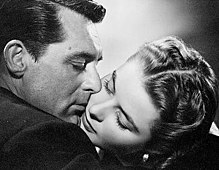
With Cary Grant in Notorious
Hitchcock films
Bergman starred in the Alfred Hitchcock films Spellbound (1945), Notorious (1946), and Under Capricorn (1949). Unlike her earlier Hitchcock films, Under Capricorn, the only one of the three made in colour, was a slow-paced costume drama, and has never received the acclaim that the other films that Bergman made with Hitchcock have. Bergman was a student of the acting coach Michael Chekhov during the 1940s. Coincidentally, it was for his role in Spellbound that Chekhov received his only Academy Award nomination.Joan of Arc (1948)
Later, Bergman received another Best Actress nomination for Joan of Arc (1948), an independent film based on the Maxwell Anderson play Joan of Lorraine, produced by Walter Wanger, and initially released through RKO. Bergman had championed the role since her arrival in Hollywood, which was one of the reasons she had played it on the Broadway stage in Anderson's play. The film was not a big hit with the public, partly because of the scandal of Bergman's affair with Italian film director Roberto Rossellini, which broke while the film was still in theatres. Even worse, it received disastrous reviews, and although nominated for several Academy Awards, did not receive a Best Picture nomination. It was subsequently shorn of 45 minutes, and it was not until its restoration to full length in 1998 and its 2004 appearance on DVD that later audiences could see it as it was intended to be shown.Between motion pictures, Bergman appeared in the stage plays Liliom, Anna Christie, and Joan of Lorraine. Furthermore, during a press conference in Washington, D.C. for the promotion of Joan of Lorraine, she protested against segregation after seeing it first hand at the theater she was acting in. This led to a lot of publicity and some hate mail.
Bergman went to Alaska during World War II to entertain American troops. Soon after the war ended, she also went to Europe for the same purpose, where she was able to see the devastation caused by the war. It was during this time that she began a relationship with the famous photographer Robert Capa. She became a smoker after needing to smoke for her role in Arch of Triumph.
Personal life
In 1937, at the age of 21, Bergman married dentist Petter Lindström, and a year and a half later had a daughter, Pia Lindström.After returning to America in 1940, she acted on Broadway before continuing to do films in Hollywood. The following year, her husband arrived from Sweden with daughter Pia. Lindström stayed in Rochester, New York, where he studied medicine and surgery at the University of Rochester. Bergman would travel to New York and stay at their small rented stucco house between films, her visits lasting from a few days to four months.
According to a Life magazine article, the "doctor regards himself as the undisputed head of the family, an idea that Ingrid accepts cheerfully." He insisted she draw the line between her film and personal life, as he has a "professional dislike for being associated with the tinseled glamor of Hollywood." Lindström later moved to San Francisco, California, where he completed his internship at a private hospital, and they continued to spend time together when she could travel between filmings.
Italian period with Rossellini: 1949–1957

With husband Roberto Rossellini in 1951

Memorial plaque on the house in Stromboli where Ingrid Bergman and Roberto Rossellini lived during filming of "Stromboli" in 1949
This affair caused a huge scandal in the United States, where it led to Bergman being denounced on the floor of the United States Senate. Ed Sullivan chose not to have her on his show, despite a poll indicating that the public wanted her to appear. However, Steve Allen, whose show was equally popular, did have her on, later explaining "the danger of trying to judge artistic activity through the prism of one's personal life."Spoto notes that Bergman had, by virtue of her roles and screen persona, placed herself "above all that". She had played a nun in The Bells of St. Mary's (1945) and a virgin saint in Joan of Arc (1948), and Bergman herself later acknowledged, "People saw me in Joan of Arc and declared me a saint. I'm not. I'm just a woman, another human being."
As a result of the scandal, Bergman returned to Italy, leaving her husband and daughter (Pia), which led to a publicized divorce and custody battle for their daughter. Bergman and Rossellini were married on 24 May 1950. In addition to Renato, they had twin daughters (born 18 June 1952): Isabella Rossellini, who became an actress and model, and Isotta Ingrid Rossellini, who became a professor of Italian literature.
Stromboli and "neorealism"
Rossellini completed five films starring Bergman between 1949 and 1955: Stromboli, Europa '51, Viaggio in Italia, Giovanna d'Arco al rogo, and La paura.He also directed her in a brief segment of his 1953 documentary film, Siamo donne (We, the Women), which was devoted to film actresses. Rossellini biographer Peter Bondanella notes that problems with communication during their marriage may have inspired his films' central themes of "solitude, grace and spirituality in a world without moral values."
In addition, Rossellini's use of a Hollywood star in his typically "neorealist" films, in which he normally used non-professional actors, did provoke negative reactions in some circles. Bondanella speculates that this change may have been intentional: he may have "intended to provoke a significant change in direction within Italian cinema." In Stromboli, Bergman's first film with Rossellini, her character was "defying audience expectations" in that Rossellini preferred to work without a script. This forced Bergman to act most of her scenes "inspired by reality while she worked", a style which Bondanella calls "a new cinema of psychological introspection." She was aware of his directing style before filming however, as Rossellini had earlier written her explaining that he worked from "a few basic ideas, developing them little by little" as a film progressed.
After separating from Rossellini, Bergman starred in Jean Renoir's Elena and Her Men (Elena et les Hommes, 1956), a romantic comedy where she played a Polish princess caught in political intrigue. Although the film wasn't a success, it has since come to be regarded as one of her best performances.
Later years: 1957–1982
Anastasia (1956)
With her starring role in 1956's Anastasia, Bergman made a triumphant return to the American screen and won the Academy Award for Best Actress for a second time. The award was accepted for her by her friend Cary Grant. Bergman would not make her first post-scandal public appearance in Hollywood until the 1958 Academy Awards, when she was the presenter of the Academy Award for Best Picture.Furthermore, she was given a standing ovation, after being introduced by Cary Grant and walking out onto the stage to present the award.Bergman would continue to alternate between performances in American and European films for the rest of her career and also made occasional appearances in television dramas such as a 1959 production of The Turn of the Screw for Ford Startime TV series for which she won an Emmy Award for Outstanding Single Performance by an Actress.
During this time, Bergman also performed in several stage plays. In addition, she married the producer Lars Schmidt, a fellow Swede, on 21 December 1958. This marriage ultimately ended in divorce in 1975. He died on 18 October 2009.
After a long hiatus, Bergman did the movie Cactus Flower in 1969, with Walter Matthau and Goldie Hawn.
In 1972, U.S. Senator Charles H. Percy entered an apology into the Congressional Record for the attack made on Bergman 22 years earlier by Edwin C. Johnson. She was the President of the Jury at the 1973 Cannes Film Festival.
Murder on the Orient Express (1974)
Bergman became one of the elite actresses to receive three Oscars when she won her third (and first for Best Supporting Actress) for her performance in Murder on the Orient Express (1974). Director Sidney Lumet offered Bergman the important part of Princess Dragomiroff, with which he felt she could win an Oscar. However, she insisted on playing the much smaller role of Greta Ohlsson, the old Swedish missionary. Lumet discussed Bergman's role:- "She had chosen a very small part, and I couldn't persuade her to change her mind. She was sweetly stubborn. But stubborn she was... Since her part was so small, I decided to film her one big scene, where she talks for almost five minutes, straight, all in one long take. A lot of actresses would have hesitated over that. She loved the idea and made the most of it. She ran the gamut of emotions. I've never seen anything like it."

Although known chiefly as a film star, Bergman strongly admired the great English stage actors and their craft. She had the opportunity to appear in London's West End, working with such stage stars as Sir Michael Redgrave in A Month in the Country (1965), Sir John Gielgud in The Constant Wife (1973) and Dame Wendy Hiller in Waters of the Moon (1977–78).
Autumn Sonata (1978)
In 1978, Bergman played in Ingmar Bergman's Autumn Sonata (Höstsonaten) for which she received her 7th Academy Award nomination and made her final performance on the big screen. In the film, Bergman plays a celebrity pianist who travels to Norway to visit her neglected daughter, played by Liv Ullmann. The film was shot in Norway. It is considered by many to be among her best performances.In 1979, Bergman hosted the AFI's Life Achievement Award Ceremony for Alfred Hitchcock.
A Woman Called Golda (1982) – her final role
In 1982 she was offered the starring role in a television mini-series, A Woman Called Golda, about the late Israeli prime minister Golda Meir. It was to be her final acting role and she was honored posthumously with a second Emmy Award for Best Actress.At first, she couldn't imagine herself acting the part of a well-known world figure whose physical appearance, especially her height, was so different from her own. Her daughter, Isabella, described Ingrid's surprise at being offered the part and the producer trying to explain to her, "People believe you and trust you, and this is what I want, because Golda Meir had the trust of the people." Isabella adds, "Now that was interesting to mother." She was also persuaded that Golda was a "grand-scale person", one that people would assume was much taller than she actually was. Chandler notes that the role "also had a special significance for her, as during World War II, Ingrid felt guilty because she had so misjudged the situation in Germany."
According to Chandler, "Ingrid's rapidly deteriorating health was a more serious problem. Insurance for Ingrid was impossible. Not only did she have cancer, but it was spreading, and if anyone had known how bad it was, no one would have gone on with the project." After viewing the series on TV, Isabella commented,
- "She never showed herself like that in life. In life, Mum showed courage. She was always a little vulnerable, courageous, but vulnerable. Mother had a sort of presence, like Golda, I was surprised to see it... When I saw her performance, I saw a mother that I'd never seen before—this woman with balls."
Death and legacy
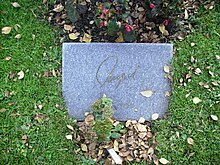
Ingrid Bergman's grave at Norra begravningsplatsen.
According to biographer Donald Spoto, she was "arguably the most international star in the history of entertainment." Acting in five languages, she was seen on stage, screen and television, and won three Academy Awards plus many others. After her American film debut in the 1939 film Intermezzo: A Love Story, co-starring Leslie Howard, Hollywood saw her as a unique actress who was completely natural in style and without need of makeup. Film critic James Agee wrote that she "not only bears a startling resemblance to an imaginable human being; she really knows how to act, in a blend of poetic grace with quiet realism."
Bergman was a tall, natural-looking, and intelligent Swedish actress, fluent in English. According to film historian David Thomson, she "always strove to be a 'true' woman", and many filmgoers identified with her:
- "There was a time in the early and mid-1940s when Bergman commanded a kind of love in America that has been hardly ever matched. In turn, it was the strength of that affection that animated the 'scandal' when she behaved like an impetuous and ambitious actress instead of a saint.":76
She continued her acting career while fighting an eight-year battle with cancer, and won international honors for her final roles. "Her spirit triumphed with remarkable grace and courage", adds Spoto. Director George Cukor once summed up her contributions to the film media when he said to her, "Do you know what I especially love about you, Ingrid, my dear? I can sum it up as your naturalness. The camera loves your beauty, your acting, and your individuality. A star must have individuality. It makes you a great star. A great star.":11
For her contributions to the motion picture industry, Bergman has a star on the Hollywood Walk of Fame at 6759 Hollywood Blvd.
Woody Guthrie wrote the erotic song "Ingrid Bergman" which references Bergman's relationship with Roberto Rosselini on the film "Stromboli". It was never recorded by Guthrie but, later found in the Woody Guthrie archives, it was put to music, and recorded, by Billy Bragg on the album Mermaid Avenue
Autobiography
In 1980, Bergman's autobiography was published under the title Ingrid Bergman: My Story. It was written with the help of Alan Burgess, and in it she discusses her childhood, her early career, her life during her time in Hollywood, the Rossellini scandal and subsequent events. The book was written after her children warned her that she would only be known through rumors and interviews if she did not tell her own story. It was through this autobiography that her affair with Robert Capa became known.Filmography
Year Film English Title Role
1930s
1932 Landskamp Girl Waiting in Line
1935 Munkbrogreven The Count of the Monk's Bridge Elsa Edlund
1935 Bränningar Ocean Breakers Karin Ingman
1935 Swedenhielms Swedenhielms Family Astrid
1935 Valborgsmässoafton Walpurgis Night Lena Bergström
1936 På solsidan On the Sunny Side Eva Bergh
1936 Intermezzo Anita Hoffman
1938 Dollar Julia Balzar
1938 En kvinnas ansikte A Woman's Face Anna Holm, aka Anna Paulsson
1938 Die Vier Gesellen The Four Companions Marianne
1939 En enda natt Only One Night Eva Beckman
1939 Intermezzo: A Love Story Anita Hoffman
1940s
1940 Juninatten June Night Kerstin Norbäc - aka Sara Nordanå
1941 Adam Had Four Sons Emilie Gallatin
1941 Rage in Heaven Stella Bergen Monrell
1941 Dr. Jekyll and Mr. Hyde Ivy Peterson
1942 Casablanca Ilsa Lund
1943 For Whom the Bell Tolls María
1943 Swedes in America (short subject) Herself
1944 Gaslight Paula Alquist Anton
1945 Saratoga Trunk Clio Dulaine
1945 Spellbound Dr. Constance Petersen
1945 The Bells of St. Mary's Sister Mary Benedict
1946 American Creed (short subject) Herself
1946 Notorious Alicia Huberman
1948 Arch of Triumph Joan Madou
1948 Joan of Arc Joan of Arc
1949 Under Capricorn Lady Henrietta Flusky
1950s
1950 Stromboli Karin
1952 Europa '51 The Greatest Love Irene Girard
1953 Siamo donne (segment: "Ingrid Bergman") We, the Women Herself
1954 Giovanna d'Arco al rogo Joan of Arc at the Stake Giovanna d'Arco (Joan of Arc)
1954 Viaggio in Italia Journey to Italy Katherine Joyce
1954 La Paura Fear Irene Wagner
1956 Anastasia Anna Koreff/Anastasia
1956 Elena et les hommes Elena and Her Men Elena Sokorowska
1958 Indiscreet Anna Kalman
1958 The Inn of the Sixth Happiness Gladys Aylward
1960s
1961 Aimez-Vous Brahms? Goodbye Again Paula Tessier
1961 Auguste Kolka, My Friend (Uncredited Cameo)
1964 The Visit Karla Zachanassian
1964 The Yellow Rolls-Royce Gerda Millett
1967 Stimulantia (Episode: "The Necklace") Mathilde Hartman
1969 Cactus Flower Stephanie Dickinson
1970s
1970 Henri Langlois (documentary) Herself
1970 A Walk in the Spring Rain Libby Meredith
1973 From the Mixed-Up Files of Mrs. Basil E. Frankweiler Mrs. Frankweiler
1974 Murder on the Orient Express Greta Ohlsson
1976 A Matter of Time Countess Sanziani
1978 Höstsonaten Autumn Sonata Charlotte Andergast
[edit] Television credits
Ingrid Bergman pinning a corsage on Bess Truman.
Year Production Role
1959 Startime: The Turn of the Screw Governess
1961 24 Hours in a Woman's Life Clare Lester
1963 Hedda Gabler Hedda Gabler
1966 The Human Voice Unnamed (monologue)
1977 Great Performances: Childhood Host
1979 The American Film Institute Salute to Alfred Hitchcock Herself (hostess)
1982 A Woman Called Golda Golda Meir
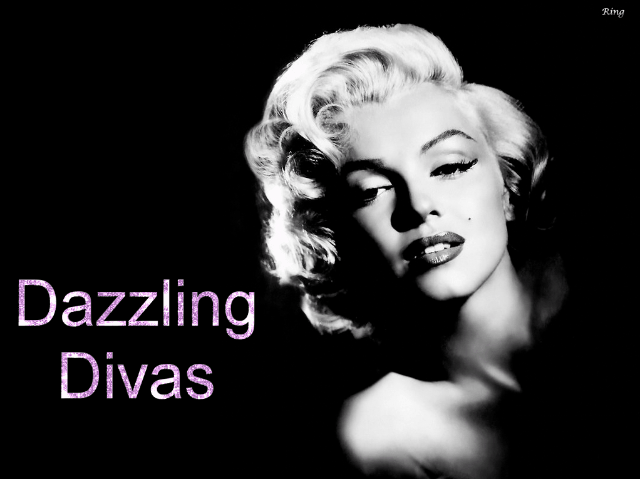









































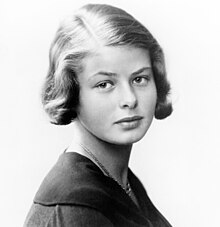
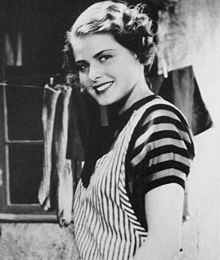


No comments:
Post a Comment